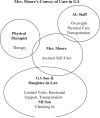Convoys of care: theorizing intersections of formal and informal care
- PMID: 23273553
- PMCID: PMC3611594
- DOI: 10.1016/j.jaging.2012.10.002
Convoys of care: theorizing intersections of formal and informal care
Abstract
Although most care to frail elders is provided informally, much of this care is paired with formal care services. Yet, common approaches to conceptualizing the formal-informal intersection often are static, do not consider self-care, and typically do not account for multi-level influences. In response, we introduce the "convoy of care" model as an alternative way to conceptualize the intersection and to theorize connections between care convoy properties and caregiver and recipient outcomes. The model draws on Kahn and Antonucci's (1980) convoy model of social relations, expanding it to include both formal and informal care providers and also incorporates theoretical and conceptual threads from life course, feminist gerontology, social ecology, and symbolic interactionist perspectives. This article synthesizes theoretical and empirical knowledge and demonstrates the convoy of care model in an increasingly popular long-term care setting, assisted living. We conceptualize care convoys as dynamic, evolving, person- and family-specific, and influenced by a host of multi-level factors. Care convoys have implications for older adults' quality of care and ability to age in place, for job satisfaction and retention among formal caregivers, and for informal caregiver burden. The model moves beyond existing conceptual work to provide a comprehensive, multi-level, multi-factor framework that can be used to inform future research, including research in other care settings, and to spark further theoretical development.
Copyright © 2012 Elsevier Inc. All rights reserved.
Figures
References
-
- Abrahamson K, Suitor JJ, Pillemer K. Conflict between nursing home staff and residents’ families. Journal of Aging and Health. 2009;21(6):895–912. - PubMed
-
- Aneshensel CS, Pearlin LI, Mullan JT, Zarit SH, Whitlatch CJ. Profiles in caregiving: The unexpected career. Academic Press; San Diego, CA: 1995.
-
- Antonucci TC. Personal characteristics, social support and social behavior. In: Binstock RH, Shanas E, editors. Handbook of aging and the social sciences. 2nd ed. Van Nostrand; New York: 1985. pp. 94–128.
-
- Antonucci TC. Measuring social support networks: A hierarchical mapping technique. Generations. 1986;10(4):10–12.
-
- Antonucci TC, Birditt KS, Akiyama H. Convoys of social relations: An interdisciplinary approach. In: Bengston VL, Gans D, Putney NM, Silverstein M, editors. Handbook of theories and aging. 2nd ed. Springer; New York: 2009. pp. 247–260.
Publication types
MeSH terms
Grants and funding
LinkOut - more resources
Full Text Sources
Other Literature Sources
Medical






